Welcome to Sandy Bridge, with the ASRock P67 Extreme4
by Ian Cutress on January 3, 2011 7:00 AM EST- Posted in
- Motherboards
- ASRock
System Benchmarks
CrystalDiskMark 3.0.1
We test the motherboard's USB 2.0 and USB 3.0 speed via CrystalDiskMark. We run the sequential test to find the optimum read/write speed, then perform a copy from the SSD to the USB device. We copy a set of 2867 files across 320 folders—95% of these files are small typical website files, and the rest (90% of the size) are the videos used in the Sorenson Squeeze test. Total size is 1.52GB
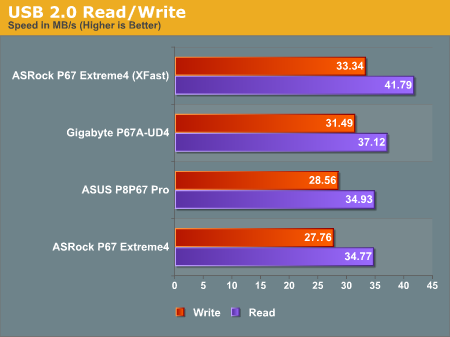
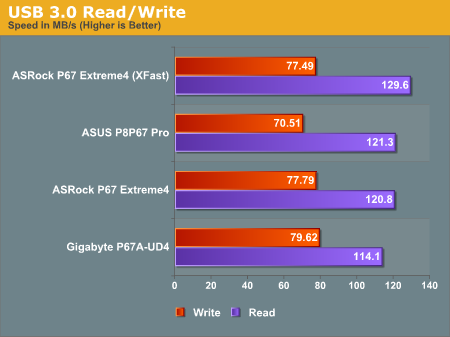

We also tested the ASRock XFast USB software. While making a slight difference to the sequential read/write speeds, it actually makes a difference in real-world situations where large amounts of small files need to be copied. USB 3.0 didn't benefit as much as USB 2.0, and it's worth noting that without XFast the USB 2.0 speed was the slowest of the three motherboards, but it does provide a benefit and turns the Extreme4 into the fastest overall USB choice.
3D Movement Algorithm Test
This benchmark is actually one I have written. My full time job involves computational chemistry, so this first benchmark uses various algorithms for three-dimensional simulation and movement of independent particles. The algorithms either employ uniform random number generation or normal distribution random number generation (with periods exceeding 2^120), and vary in various amounts of trigonometric operations, conditional statements, generation and rejection, fused operations, etc. The benchmark runs through six algorithms for a specified number of particles and steps, and calculates the speed of each algorithm, then sums them all for a final score. This is an example of a real world situation that a computational scientist may find themselves in, rather than a pure synthetic benchmark. The benchmark is also parallel between particles simulated, and we test the single thread performance as well as the multi-threaded performance.

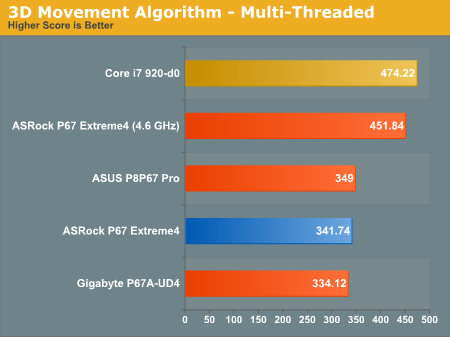
As expected, the single thread performance with the Sandy Bridge processor over the i7-920. This is in part due to the difference in speed in single-thread mode, but also to the increased logic on the Sandy Bridge processor. In the multi-threaded test, it's a case of available threads - the i5-2500K has 4 cores/4 threads available, whereas the i7-920 has 4 cores/8 threads available. In both tests, the ASRock performs well, being beaten (just) by the P8P67 Pro.
With 64-bit WinRAR, we compress a set of 2867 files across 320 folders—95% of these files are small typical website files, and the rest (90% of the size) are the videos used in the Sorenson Squeeze test. Total size is 1.52GB. WinRAR x64 3.93 attempts to use multithreading when possible.
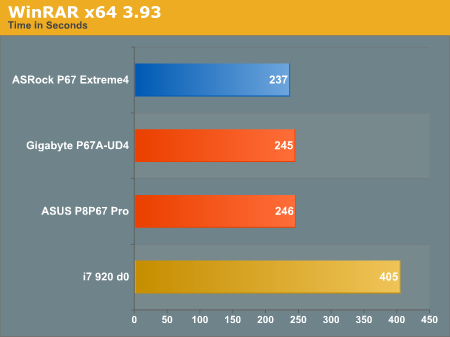
FastStone Image Viewer 4.2
FastStone Image Viewer is a free piece of software I have been using for quite a few years now. It allows quick viewing of flat images, as well as resizing, changing color depth, adding simple text or simple filters. It also has a bulk image conversion tool, which we use here. The software currently operates only in single-threaded mode, which should change in later versions of the software. For this test, we convert a series of 170 files, of various resolutions, dimensions and types (of a total size of 163MB), all to the .gif format of 640x480 dimensions.
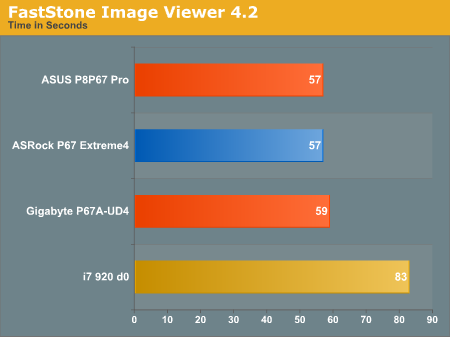
Sorenson Squeeze 6.0
Sorenson Squeeze is a professional video encoder, complete and rife with options. For this test, we convert 33 HD videos, each a minute long and approximately 42 MB in size, to WMV 512KBps format. Squeeze can encode multiple videos at once, one for each thread.
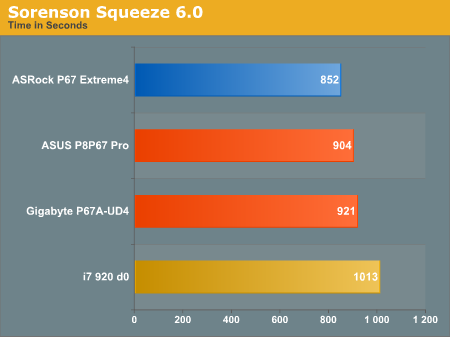
Overview
The ASRock board has relatively mediocre USB speeds, until XFast is used. In general, this board does fairly well across the entire 2D benchmark suite, either being at the top or near the top.










55 Comments
View All Comments
Mazlov - Tuesday, January 4, 2011 - link
Having read all the SB articles on AT, I must admit that I too feel that this platform is getting a bit more attention than it deserves. I suspect this is because X58 has been around for such a long time, and enthousiasts are eag to get their hands on something new.In reality, SB, although providing us with a very decent performance upgrade, is not all that exciting. IPC does not seem to have improved very much. Much of the improvement seems to be realized by the higher stock clocks and excellent Turbo. Both of which are a direct result of the new 32nm production process.
The thing that realy bothers me though, is that the chipsets look as if it's still 2009. With the exception of sata-600, nothing about the SB platform is particularly modern. No onboard usb3, not a trace of Light Peak (while Apple is rumoured to have it on Macs this year), no pci-e 3.0 (understandable since it has only rercently been finalized). Looks to me as if Intel is indeed hostage of their own time schedule.
To make matters even worse. Intel has taken their market segmentation one step further, by increasing the amount of different chipsets. All with their own limitations.
Now I'm not saying that SB is a bad product. For over ninety percent of consumers it will fit perfectly. Whether it is good enough for us enthousiasts... I doubt it. 2011 will see some interesting new technologies and SB sadly does not seem to support them yet. If you are a hardware enthousiast, unless you are willing to upgrade again at the end of this year, SB is not for you.
mapesdhs - Wednesday, January 5, 2011 - link
Two 8X PCIE is more than sufficient for SLI/CF with the vast majority of games/apps
using anything other than perhaps the highest end GPUs. naturally X58 favours 3-way/4-way CF/SLI, but few games benefit significantly from these modes (to the
extent that the entire additional platforum cost is worthwhile) and some games perform
worse.
Likewise, dual-channel RAM is also plenty, especially since unlike X58 the
P55 platform does not suffer from the 'vanishing' RAM channel problem when overclocking.
However, I do agree that X58 is hardly dead for those who've bought them. Very
few users will really *need* the extra speed offered by SNB CPUs, and all those
with 920/930 CPUs have the 6-core options which will come down in price.
But don't claim that dual 16X PCIE and 3-channel RAM is essential for high
performance because that's just plain wrong. With the help of a friend who has
an i7 930 system with two GTX 460 SLI, I've accumulated a plethora of benchmark
results which show what I mean (my system is an i7 870 @ 4270MHz, dual EVGA
GTX 460 1GB FTW SLI). Google for "3DMark06 Benchmark SGI Depot", see the
end of the page for the URLs of the other _nine_ pages of performance results,
more added daily/weekly when I & my friend are able.
QED.
Ian.
jp9700 - Monday, January 3, 2011 - link
I just wanted to thank you for including your "3D Movement" benchmark. I do a fair amount of computational chemistry myself (although generally quantum mechanics), and I find it incredibly hard to find applicable benchmarks on new hardware.jimhsu - Monday, January 3, 2011 - link
Seconded ... most of the scientific community is notoriously conservative when it comes to publishing relevant benchmarks for scientific applications on new hardware. Often, the best you can do is hear from a colleague that "Lab X upgraded to Y and got good results" or "Dr. A. (who published in Nature, Cell, Science, whatever) has 10K in grant money and bought that, so we should too". On rare cases you might see an anecdotal report on a group's public website that tests a single config against another particular configuration and shows a % improvement ... those are rare though.DesktopMan - Monday, January 3, 2011 - link
When are they getting rid of the Realtek hardware? The Realtek audio drivers have given me nothing but trouble for years. Isn't there support for gbit ethernet in the platform as well, but board manufacturers choose not to use them? Remember reading about that last bit but not entirely sure if I remember correctly.wolfman3k5 - Monday, January 3, 2011 - link
When something CHEAPER and BETTER will come along. And if you're complaining about Realtek, well, do you remember the old audio codecs that where used in the past before Realtek?dgobe - Monday, January 3, 2011 - link
It would be nice to see an i7 920(OC'd) vs an i7 2600K at the same clock speed. Turbo off, just to see how the two architectures compare.wolfman3k5 - Monday, January 3, 2011 - link
You won't see that because the idea is to throw out the old and buy new. Line your pockets people, in a couple of days you'll be able to buy shiny new toys at newegg.com. As for everyone else, keep and eye on eBay for tons of cheap used CPUs and Mobos.landerf - Monday, January 3, 2011 - link
About the bandwidth (muti 3d test), while clock for clock yes 1155 only beats 1156, at max speed it should pass or match 1366 as 1366 is speed limited. That's why I bought 8 gbs of 2400mhz ram in prep for sandy.GTVic - Monday, January 3, 2011 - link
I've seen very little information on UEFI, do some Sandy Bridge motherboards have a BIOS or do they all have UEFI.Also, this motherboard has two PS2 ports and a floppy connector. I have seen several Sandy Bridge motherboards which have no IDE, no floppy, no serial/parallel ports and only one blue/green PS2 port. So this motherboard seems to be catering to people with legacy requirements. I think the need for a floppy connector is overstated.